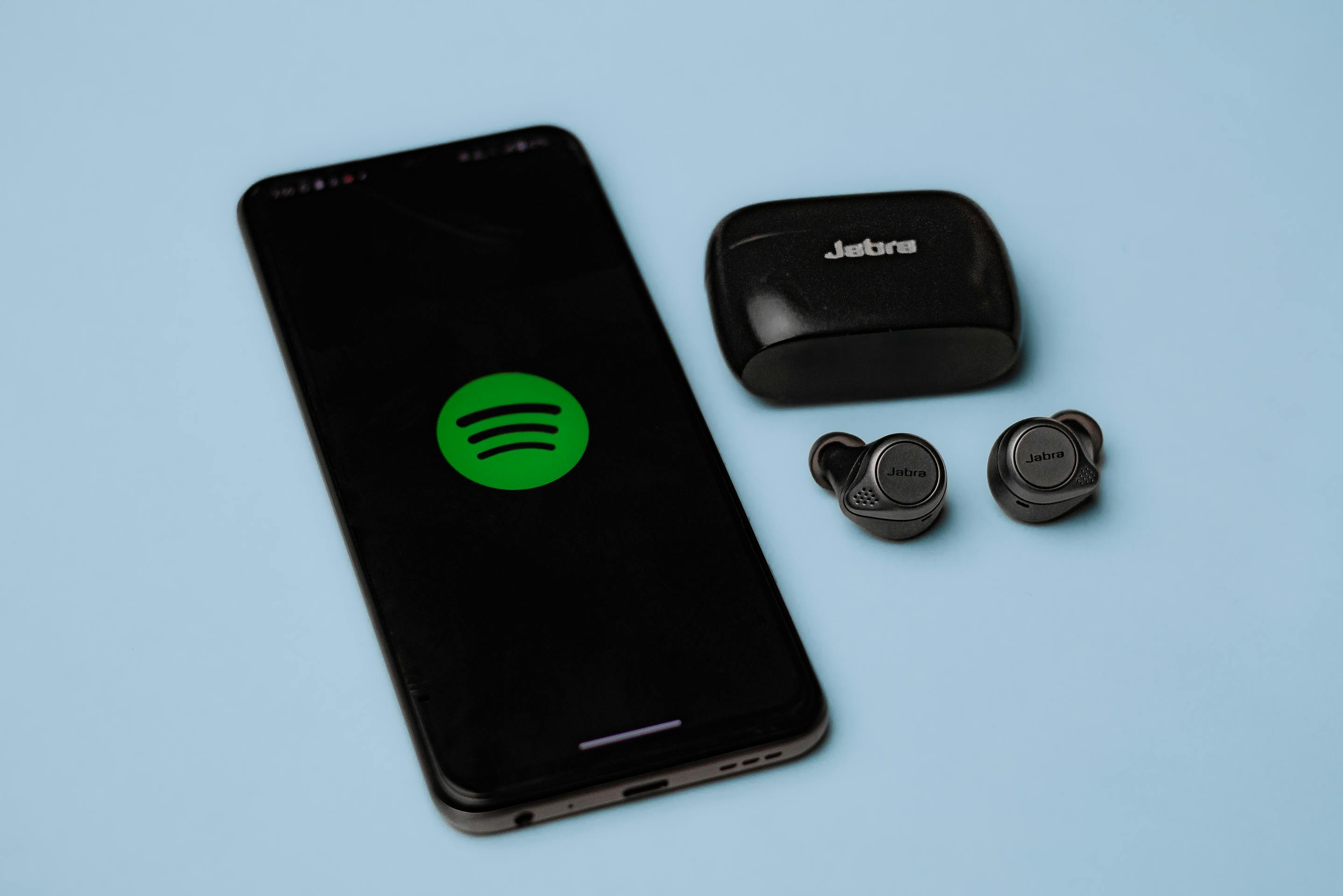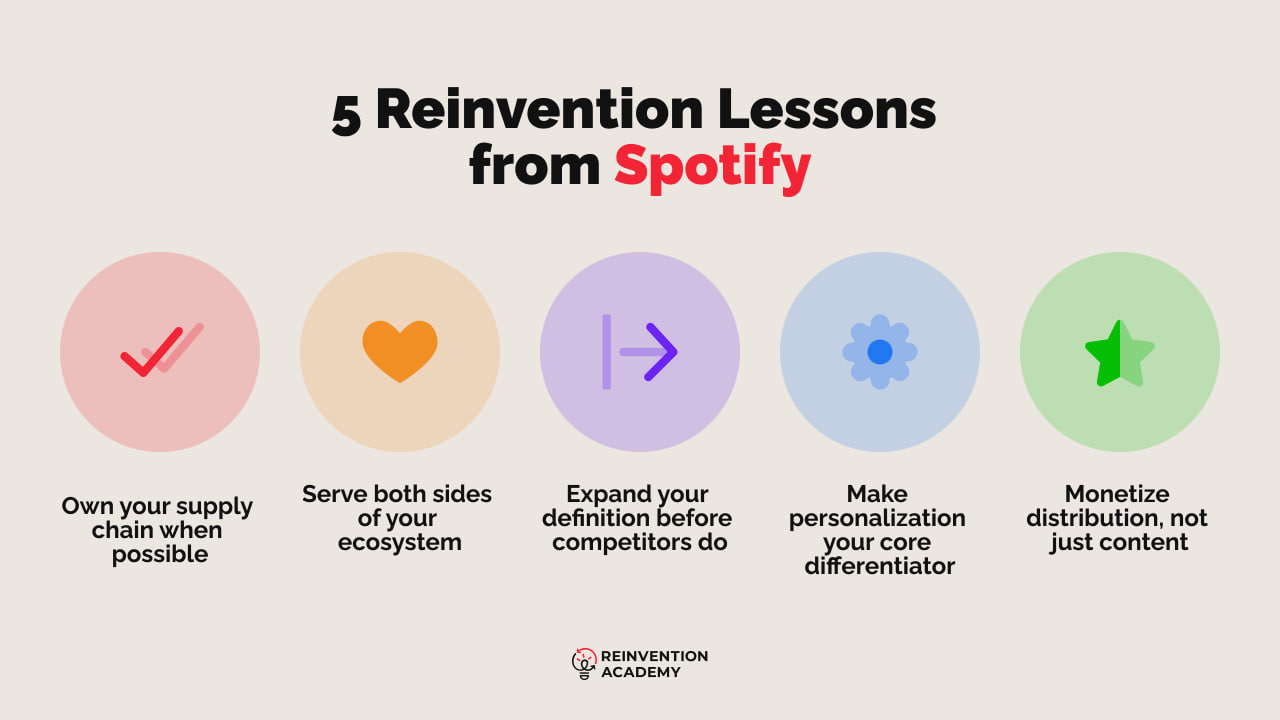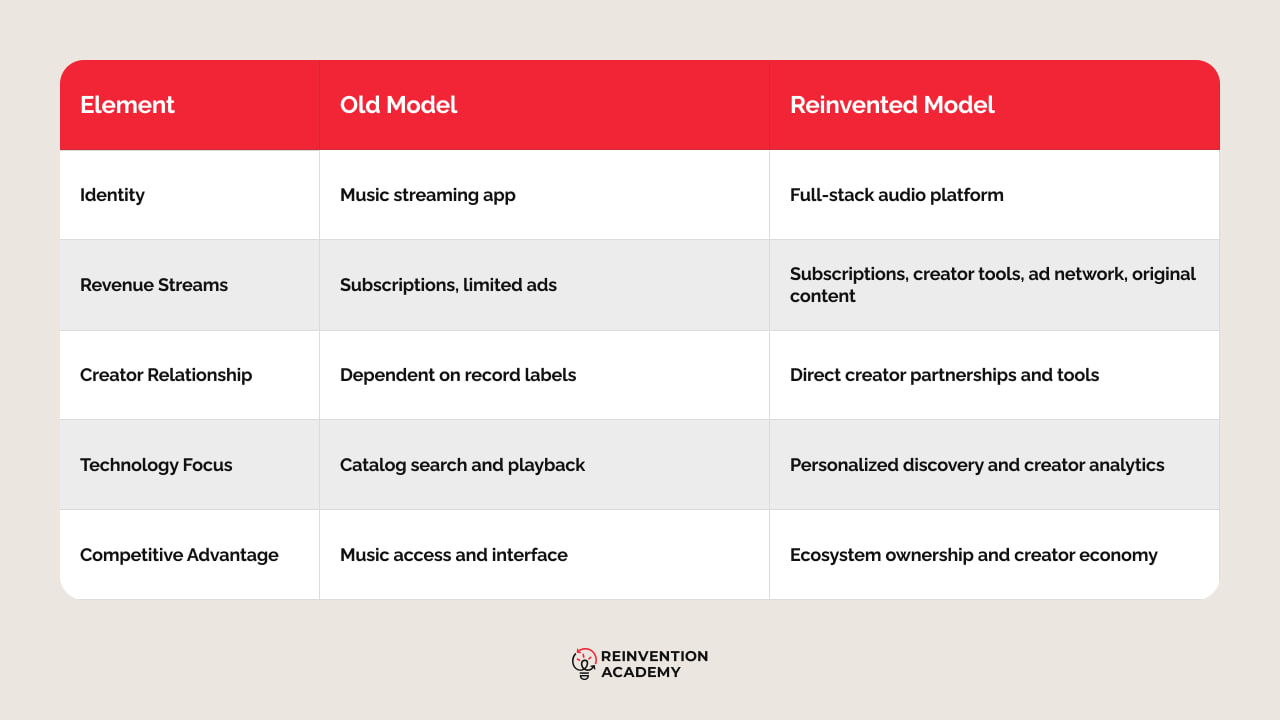From Beats to Billions: Spotify's Creator-First Reinvention Story
How Spotify went from simple music streaming to a €15.6B audio ecosystem with podcasts, creative tools, and personalized algorithms.

Spotify Technology S.A. (SPOT) is an audio streaming service based in Sweden that serves 184 countries and territories. In 2006, Daniel Ek and Martin Lorentzon founded the company, which posted a revenue of €15.673 billion in 2024, its first full-year net profit of €1.138 billion. The platform has 263 million subscriptions and 675 million monthly active users. Originally launched as a music streaming platform, it has now become the world’s biggest audio platform.
This Spotify case study reveals how a music streaming app shed its original identity to become something bigger. From fighting music piracy in 2006 to owning the creator economy in 2025, the Spotify business strategy proves that sometimes you must break your rules to win the next game.
Why Spotify Needed Reinvention
Spotify's failure was not the cause of the audio platform transformation. The company paid $10 billion in music royalties last year, which shows that it is still lucrative. But smart leaders understand that success today does not mean success tomorrow.
Four problems demanded action:
1. Music licensing costs were crushing margins
Record labels controlled the content. Spotify paid them massive fees but couldn't differentiate itself from competitors. Every streaming service offered the same songs. Price wars meant smaller profits on each subscription.
2. Tech giants bundled music with everything else
Apple included Apple Music with device purchases. Amazon bundled Prime Music with shopping benefits. Google connected YouTube Music to their video platform. Spotify couldn't compete with companies that treated music as a loss leader.
3. The Creator economy was exploding without Spotify
YouTube paid creators billions annually. TikTok made unknown artists famous overnight. Patreon lets fans pay creators directly. Musicians and podcasters needed more than just distribution. They wanted tools, analytics, and direct fan relationships.
4. Competition was expanding beyond music
Amazon's Audible dominated audiobooks. YouTube-controlled video podcasts. SiriusXM owned live radio and sports. Spotify's competitors weren't just other music apps. They were entire media ecosystems.
Dr. Nadya Zhexembayeva describes this as the "expansion trap." Success in one area blinds companies to opportunities in adjacent markets. Spotify vs Apple Music strategy wasn't enough. Spotify needed to compete against the entire attention economy.
Spotify's Reinvention Strategy: Content, Creators, and Control
The Spotify podcast strategy became the foundation for everything else.
1. Expanding Into the Audio Ecosystem
Music streaming services are commodities. Audio platforms are ecosystems. Spotify bought Anchor for $154 million in 2019 to let anyone create podcasts for free. They acquired Megaphone for $235 million to handle enterprise podcast hosting and advertising. Gimlet Media and Parcast acquisitions brought premium content creation in-house.
The moves weren't random. Spotify now hosts about 6.5 million podcast titles, including 330,000 video podcast shows. More than 250 million users have watched a video podcast on Spotify, with an 88% surge in video podcast consumption in the past year alone.
People don't just listen to music anymore. They consume audio during workouts, commutes, cooking, and working. Spotify captured all those moments with different content types for different activities.
2. Becoming Creator-First
The Spotify creator platform gives podcasters and musicians what they actually need: control.
Spotify for Creators (previously Spotify for Podcasters) turned out to be a one-stop shop for audio and video creators to upload their work, check performance, engage with fans, and monetize their respective shows. The creators receive insightful information about who listens to them, as well as when and where. They can add Q&A sections and polls to episodes. Comments and direct fan engagement happen inside the app.
Spotify content monetization works multiple ways. The Spotify Partner Program pays video podcast creators based on Premium user watch time. Partnership with Patreon enables creators to expand their business through direct fan payments while allowing fans to listen to Patreon content on Spotify. Ad revenue sharing gives creators a cut of advertising dollars.
This strategy worked. Since the beginning of Rogan’s exclusive partnership with Spotify, overall podcast consumption grew 232% and ad revenue increased by 80% from 2021 to 2023.
3. Dominating the Podcast Economy
Huge exclusive deals were the first Spotify original content. Joe Rogan signed a multiyear deal to host his own show. By securing deals with notable figures such as Barack and Michelle Obama, Meghan Markle and Prince Harry, and Alex Cooper’s “Call Her Daddy,” Spotify has become the exclusive destination for marquee content.
The strategy evolved—Rogan's $250 million 2024 renewal shifts from previous platform exclusivity. Spotify has started managing distribution and ad sales on Apple Podcasts, Amazon Music, and YouTube. The shift prioritizes monetization over exclusivity.
Why the change? Exclusive deals convert listeners from other platforms poorly, according to Gimlet and Parcast workers' unions. But ad sales generate revenue regardless of where people listen. Spotify makes money selling ads on Rogan's show, whether fans listen on Spotify or Apple Podcasts.
Two Enablers That Drove the Shift
While strategy gets the headlines, Spotify's transformation succeeded because of two internal capabilities that turned ambitious plans into €15.6 billion in annual revenue.
1. Personalized Technology Infrastructure
Spotify algorithm and personalization created emotional loyalty that competitors couldn't match. Discover Weekly playlists introduced users to new music every Monday. Daily Mix combined familiar favorites with fresh discoveries. Spotify Wrapped became an annual cultural event where users shared their listening data like trophies. Spotify's 10th annual Wrapped campaign delivered strong user engagement with 10% year-over-year growth across 184 markets and 53 languages.
The technology also serves creators. Spotify's algorithm gives podcasters insights into popular topics. Creators see when listeners drop off during episodes and which segments get replayed the most. This data helps them improve content and attract sponsors.
Spotify's business strategy made personalization the product, not a feature. Other platforms offer recommendations. Spotify creates relationships between users and their audio identity.
2. In-House Content and Platform Integration
Reinvention in the music industry required owning the entire value chain. Spotify built recording studios, hired production teams, and created original shows. They didn't just distribute content. They made it. This gave them editorial control, cost management, and intellectual property ownership.
The flywheel effect kicked in. Better content attracted more users. More users attracted more creators. More creators produced more content. Higher engagement justified higher ad rates. Revenue funded more original content.

Dr. Nadya Zhexembayeva's Reinvention Lens on Spotify
The Spotify case study on reinvention perfectly demonstrates Dr. Nadya's platform reinvention model.
- Letting Go: Spotify abandoned the "music streaming service" identity that made them successful. They stopped competing on music catalog size and started competing on audio ecosystem completeness.
- Alignment: Leadership aligned strategy with creator economy expansion and shifts in audio consumption. They did not resist the trend of video podcasts and creator monetization; they welcomed it.
- Platform Thinking: Spotify has changed from a product (access to music) to an infrastructure (creation and distribution of audio and monetization). Other companies create their own businesses using Spotify’s tools.
- Embedded Innovation: Personalization and creator tools became core to every user interaction, not optional features added later.
Dr. Nadya would recognize Spotify's approach: "Great reinvention doesn't just change what you sell. It changes how value gets created and shared in your entire industry."
5 Reinvention Lessons from Spotify for Business Leaders
- Expand your definition before competitors do. Spotify moved from "music streaming" to "audio platform" before others understood the opportunity. Amazon still treats music as a Prime benefit add-on. Apple bundles music with device sales. Spotify made audio the primary business.
- Serve both sides of your ecosystem. How Spotify reinvented itself involved equal focus on listeners and creators. Most platforms optimize for one side. Spotify gives creators tools, analytics, and revenue while giving listeners discovery, personalization, and community.
- Make personalization your core differentiator. Every streaming service has similar content. Spotify's recommendation algorithm and user experience create switching costs that go beyond content access. Users stay because Spotify understands their audio identity.
- Own your supply chain when possible. Spotify couldn't control music licensing costs, so it created its own content through podcast studios and original productions. This gives Spotify margin control and differentiation that licensed content can't provide.
- Monetize distribution, not just content. The Joe Rogan deal evolution shows this perfectly. Spotify makes more money handling ad sales across all platforms than keeping exclusive content on its platform only.
Spotify Reinvention at a Glance

Final Note: Why Spotify's Reinvention Hits the Right Note
In 2024, Spotify recorded its first full-year profit of €1.138 billion in net income. However, financial success isn't the most important part of this story.
Business leaders should ask these questions:
- What adjacent markets could expand your definition? Spotify went from music to audio to a creator economy. Where could your core competency create value in new categories?
- How can you serve both supply and demand in your market? Most companies optimize for customers or suppliers. The biggest opportunities come from platforms that help both sides succeed together.
This Spotify case study proves that market leaders can reinvent themselves before disruption forces change. They didn't wait for a crisis. They created their own transformation when they had the resources and market position to do it right.


.svg)